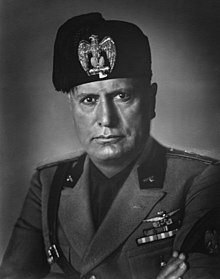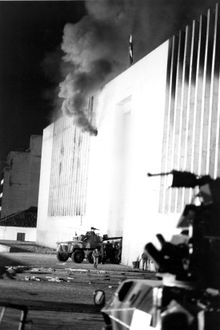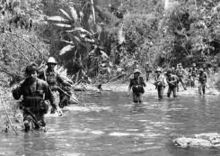Difference between revisions of "Rubicon War"
| Line 245: | Line 245: | ||
=== Operation Saulo === | === Operation Saulo === | ||
| + | |||
| + | {{main|Operation Saulo}} | ||
[[File:FireofTownHall.jpg|thumb|right|220px|The capitol building of Guiraiso burning on 7 March 1962.]] | [[File:FireofTownHall.jpg|thumb|right|220px|The capitol building of Guiraiso burning on 7 March 1962.]] | ||
Revision as of 15:49, 26 March 2022
The Rubicon War (Creeperian Spanish: Guerra del Rubicón; Salisfordian: Guerra del Rubicone) was a major war in Sur which occurred in two phases between 1961 and 1976. The war was fought between Creeperopolis and Salisford over a territorial dispute along the Rubicon River, which marked the border between the two nations. Despite the Salisfordian military victory in the first phase and the Creeperian military victory in the second phase, the war ended in a diplomatic stalemate as neither Salisford nor Creeperopolis made any significant gains as a result of the conflict.
In 1936 during the Creeperian Civil War, the Catholic Imperial Restoration Council (Imperial Council) made a secret agreement with the Salisfordian government to partition the nation of Castilliano in an effort to end a brief conflict being fought between Castilliano and Salisford and to get the Salisfordians to send volunteers to help the Imperial Council against the National Council for Peace and Order (National Council). Despite the agreement, after the war ended in 1949 and Castilliano was annexed by Creeperopolis, the Creeperian government did not allow Salisford to take territory from Castilliano as was promised due to Creeperopolis making a separate agreement with Castilliano ensuring their protection. In 1952, Salisfordian First Minister Sandro Neri pressed Creeperopolis to fulfill the agreement and cede the promised territory to Salisford, however, the Creeperian government refused citing all of Castilliano as "an integral part of Creeperopolis."
After an increase in anti-government protests in the Castillianan departments and the assassinations of two Castillianan independence activists, Neri again pressed the Creeperian government to cede the territory, which were again rejected. The two nations entered into negotiations to settle the disputed territory, however, in 1961, a skirmish between Creeperian and Salisfordian soldiers along the Rubicon River brought a sudden end to the negotiations and tensions between both nations rose. As both nations began to mobilize their soldiers in preparation of war, Salisford invaded Creeperopolis on 13 October 1961 with the objective of securing the entire Salisfordian claim.
Contents
Background
Conflicts between Castilliano and Salisford
Rubicon Incident
In 1936, diplomatic relations between Salisford and Castilliano strained, mostly as a result of the arrest of Humér Paguét e Fonts, a Castillianan diplomat, who was charged with multiple counts of sexual misconduct and rape against various Salisfordian women.[1] Castilliano rejected the Salisfordian charges, denying that Paguét e Fonts had any involvement with the alleged misconduct and rape and accused the Salisfordian government of arresting him for political reasons, as Paguét e Fonts had voiced criticisms of Leonardo Bari, the first minister of Salisford.
With tensions high between the two nations, Salisford moved troops across the border with Castilliano and into Sant Pau (present-day San Pablo), citing historical claims to the northern territories of the region. Castilliano would reject the claims, accused Salisford of starting a war over a diplomatic incident hiding under the guise of "historical claims," and moved troops to intercept the Salisfordian soldiers. Both sides clashed and the fighting developed into a three-week long intense border conflict.[2] Before any side made a breakthrough, the Catholic Imperial Restoration Council (Imperial Council), concerned about the possibility of further escalation between the two nations, stepped in and helped negotiate an end to the fighting.[3]
To convince the dissatisfied Salisfordian administration to agree to end the conflict, Adolfo Cabañeras Moreno, the minister of defense of the Imperial Council, secretly negotiated a deal with Bari to partition Castilliano sometime in the near future, promising Salisford the northern half of the country. In return, the Salisfordians agreed to send an expeditionary force to assist the Imperial Council in breaking the stalemate which has developed in the Creeperian Civil War.[3]
After an agreement was reached with the Salisfordians, Cabañeras Moreno then approached Óscar Benléu e Laréira, the prime minister of Castilliano, and informed him of the "agreement" that he had negotiated with the Salisfordians, telling him that he had no intentions of actually going through with the plan and that it was only an effort to end the conflict. He assured Benléu e Laréira that Creeperopolis would support Castilliano in any war should Salisford attempt to enforce the false agreement which was made.[4]
After consulting with both sides in secret, the Imperial Council publicly offered to mediate peace between the two nations. Both nations met in the city of Guiraiso and formulated that Rubicon Agreement, which both nations agreed to.[5] Cabañeras Moreno, Bari, and Benléu e Laréira were all in attendance of the signing of the agreement, which acted as a peace treaty between Castilliano and Salisford. The criminal charges against Paguét e Fonts were dropped by the Salisfordian government as a part of the agreement.
Annexation of Castilliano and social unrest
Following the conclusion of the civil war in 1949, Castilliano held a referendum on 1 December 1949 to decide if it should be annexed by Creeperopolis or not. The referendum resulted in favor of annexation by a large margin, but many called into question the legitimacy and the legality of the votes and the referendum itself. Despite the brewing controversy, the ruling party of Castilliano, the right-wing Castillianan Coalition of Autonomous Rights (CCDA), which heavily campaigned in favor of the referendum, accepted the results of the vote and Creeperopolis formally annexed Castilliano on 25 December 1949. The annexation was also supported by Benléu e Laréira, Agostéia Martéu e Puéi, and Efraïne Carból e Fórtrosa-Dóna, all of whom served as prime minister of Castilliano after the 1934 Castillianan coup d'état.
After Creeperopolis' annexation of Castilliano, various left-wing groups formed the Union of Castillianan Opposition Forces (UFOC), formed as the successor of the left-wing Coalition of the United Social Left (CESU) which was banned by the Castillianan military government in 1937. The Union of Castillianan Opposition Forces, otherwise known as simply the Opposition, was led by Abél Uriéra e Chicote,[6] Joaquín Córsega e Rubiéra, and Eusebio Lancóme e Moléu, all of whom had previously served as the leader of the Coalition of the United Social Left, with Uriéra e Chicote and Córsega e Rubiéra also serving as prime ministers of Castilliano.[6]
The Opposition heavily criticized Carból e Fórtrosa-Dóna's decision to allow annexation into Creeperopolis and denounced him and the Castillianan Coalition of Autonomous Rights, declaring them "Traitors to the Fatherland." Carból e Fórtrosa-Dóna was appointed as captain general of the department of Castilliano by the Creeperian government and cracked down on the Opposition's activities, arresting its leaders and protestors. As the Opposition refused to recognize the annexation of Creeperopolis and opposed Carból e Fórtrosa-Dóna's administration, the organization was declared as a terrorist organization by the Creeperian government.
In the 1950s, the National Intelligence Directorate (DINA) carried out operations which assassinated each of the three leaders of the Coalition of the United Social Left, presumably at the request of Carból e Fórtrosa-Dóna. Uriéra e Chicote was shot by a group of armed DINA agents in San Pablo in March 1952.[6] In June 1958, Córsega e Rubiéra was killed by a car bomb planted by the DINA in Santa María. Finally, Lancóme e Moléu was killed by a DINA sniper in Ciudad Los'Ángeles. The assassinations of the Opposition's three leaders caused many of its other prominent leaders to flee the country or go into hiding.
In 1960, Guilhém Garçon e Justament was proclaimed as the leader of the Opposition. He called for Castillianans across the country to rise up in protest against the Creeperian government for the independence of Castilliano. The protests of early-1961 occurred across the Castillianan departments of Castilliano, San Pablo, Santa María, and Sonsonate, with an estimated 100,000 to 200,000 people marching in protest of Creeperian rule. The government responded with military force to suppress the protests leading to hundreds of deaths and thousands of arrests.
Rise of Sandro Neri in Salisford
In 1945, King Francesco I died of lung cancer, ending his relatively conservative reign in Salisford. His eldest daughter, Maria, succeeded him as Queen Maria III. During the first years of her reign, Maria III established herself a reputation of being liberal-minded monarch, seeking to reform Salisford's traditional institutions in favor of new ones which she perceived to be more modern and democratic. To aid her, she offered amnesty to the previously-exiled academic Giacomo Ottone and appointed him as her first minister. Together, Maria III and Ottone attempted to transform Salisford into what they described as "a modern country worthy of Ecros."
Maria III and Ottone went about reforming Salisford in a heavy-handed manner, brushing aside the concerns of conservatives and moderates, and alienating many traditional power bases in Salisford, most notably the nobility and the military. Their actions caused much controversy within the country, which led to a number of opponents to their reforms to form the Catholic Front, an organized opposition group to the attempted reforms.
In 1950, after an attempt by Maria III to dissolve the Catholic Front, Major General Sandro Neri, the commander of the Salisfordian volunteers in Creeperopolis, crossed the Rubicon River and declared that Maria III's government was illegitimate. After a brief military struggle, Neri entered the city of Savotta on 3 November 1950 and dissolved the Salisfordian government. The following day, Maria III appointed Neri as her new first minister and formally ceded all political power to him.
In late-1952, Neri was made aware of the secret agreement made between Creeperopolis and Salisford during Bari's administration and decided to press the Creeperian government to fulfill the agreement that was made back in 1936, especially after the assassination of Uriéra e Chicote by the Creeperian government earlier in the year. Despite the agreement to cede Castillianan land to Salisford, Creeperopolis refused to cede any land to Salisford after Castilliano had already been annexed. Alfonso Cabañeras Moreno, who had succeeded his older his brother as minister of defense in 1944, stated that he was under obligation to fulfill the agreement, as the agreement was made by his older brother and not himself, and that even his older brother never intended to fulfill the agreement, mentioning the secret agreement made with Castilliano to defend it in the event the Salisford ever attempted to enforce its claim. He also stated that, regardless, the annexation referendum was for Castilliano in its entirety, and that the land that Salisford claimed was included in the referendum.
Prelude
Salisford claims the department of San Pablo
Attempts to negotiate territorial dispute
Skirmish of 4 February
Mobilization of soldiers
Order of battle
Creeperopolis
 Creeperian Army
Creeperian Army
 32nd Army – General Raimundo Serrano Suñer[note 1]
32nd Army – General Raimundo Serrano Suñer[note 1]
 91st Infantry Division – Lieutenant General Gustau Riviéra e Cabriéra
91st Infantry Division – Lieutenant General Gustau Riviéra e Cabriéra
- 67th Infantry Battalion – Brigadier Romulo Enríquez Revelo
- 74th Infantry Battalion – Brigadier Alexandre Léon e Pérre
- 75th Infantry Battalion – Brigadier Fabián León Flores
- 80th Infantry Battalion – Brigadier Maximiliér Alvaréu e Alvaréu
- 81st Infantry Battalion – Brigadier Sergio Zorro Juárez
- 16th Engineer Company – Lieutenant Colonel Enrique Hidalgo Fuentes
 36th Mechanized Division – Lieutenant General Armando Pacheco Jalisco
36th Mechanized Division – Lieutenant General Armando Pacheco Jalisco
- 16th Mechanized Battalion – Brigadier Cristól Escócia e Piéira
- 17th Mechanized Battalion – Brigadier Félix Casanova Bermúdez
- 23rd Mechanized Battalion – Brigadier Xavier Montt Salinas
- 28th Mechanized Battalion – Brigadier Juan Duarte Linares
- 30th Mechanized Battalion – Brigadier Pablo Córdoba Galván
- 17th Engineer Company – Lieutenant Colonel Norberto Ureña Iñez
 22nd Armored Division – Lieutenant General José Fuentes Castro
22nd Armored Division – Lieutenant General José Fuentes Castro
- 8th Armored Battalion – Brigadier José Nuñez Payés
- 16th Armored Battalion – Brigadier Marcéu Guerriér e Rosér
- 22nd Armored Battalion – Brigadier Carles Carriéra e Flors
- 24th Armored Battalion – Brigadier Vicente Fernández Jalisco
- 30th Armored Battalion – Brigadier Héctor Rodríguez Molina
 30th Artillery Division – Lieutenant General Léonard Ramiéra e Umana
30th Artillery Division – Lieutenant General Léonard Ramiéra e Umana
- 34th Artillery Battalion – Brigadier Jórdi Cadiérs e Guilhém
- 35th Artillery Battalion – Brigadier Alfonso Dávalos Herrador
- 43rd Artillery Battalion – Brigadier Danielér Serán e Lóbi
- 45th Artillery Battalion – Brigadier Gonzalo Sánchez Obregón
 Creeperian Air Force
Creeperian Air Force
 18th Air Force Wing – General Fidel Salinas Quijada
18th Air Force Wing – General Fidel Salinas Quijada
- 22nd Air Force Division – Lieutenant General Osiel López Pérez
- 22nd Air Force Battalion – Major General Alfonso Cárdenas Guillén
- 28th Air Force Battalion – Major General Santiago Castañeda Murillo
- 32nd Air Force Division – Lieutenant General Roberto Quijada Ureña
- 31st Air Force Battalion – Major General Adelso Anaya Gutiérrez
- 32nd Air Force Battalion – Major General Nicolás Valdéz Zaragoza
- 22nd Air Force Division – Lieutenant General Osiel López Pérez
 Creeperian Navy
Creeperian Navy
 5th Flotilla – Admiral Adolfo Suárez Figueroa
5th Flotilla – Admiral Adolfo Suárez Figueroa
- 1st Fleet – Vice Admiral Armando Piñón Castro
- 1st Sector – Rear Admiral Enrique Larrañaga Gaitán
- 2nd Sector – Rear Admiral Alexander Dávalos Hernández
- 2nd Fleet – Vice Admiral Pío Fuentes González
- 3rd Sector – Rear Admiral Jorge Obregón Salinas
- 4th Sector – Rear Admiral Gonzalo Pérez Zaldívar
- 1st Fleet – Vice Admiral Armando Piñón Castro
Salisford
 Royal Salisfordian Army
Royal Salisfordian Army
 3rd Brigade – Lieutenant General Antiamo Marchetti
3rd Brigade – Lieutenant General Antiamo Marchetti
 147th Paratroopers Regiment – Colonel Giacomo Conte
147th Paratroopers Regiment – Colonel Giacomo Conte
 42nd Infantry Regiment – Brigadier General Omar Bianchi
42nd Infantry Regiment – Brigadier General Omar Bianchi
- 17th Savari Battalion – Colonel Marthese Benedetti
- 21st Ascari Battalion – Colonel Gaetano Falzon
- 37th Ascari Battalion – Colonel Antonino Saliba
- 41st Ascari Battalion – Colonel Arturo Zerafa
- 132nd Engineer Battalion – Lieutenant Colonel Furio Sala
- 103rd Artillery Battalion – Lieutenant Colonel Tristano Ferretti
 75th Infantry Regiment – Brigadier General Renzo Testa[note 2]
75th Infantry Regiment – Brigadier General Renzo Testa[note 2]
- 15th Hussar Battalion – Colonel Coreno Ciresi
- 22nd Infantry Battalion – Colonel Paolo Buono
- 51st Infantry Battalion – Colonel Carlo Terazzo
- 58th Infantry Battalion – Colonel Lorenzo Casella
- 107th Engineer Battalion – Lieutenant Colonel Salvatore Rosi
- 111st Artillery Battalion – Lieutenant Colonel Luca Pagono
 4th Armored Regiment – Brigadier General Vincenzo Moretti
4th Armored Regiment – Brigadier General Vincenzo Moretti
- 24th Dragoon Battalion – Colonel Matteo Neri
- 2nd Armored Battalion – Colonel Lucio Bertone
- 11th Mechanized Battalion – Colonel Edmondo Pisoni
- 18th Mechanized Battalion – Colonel Fabrizio Dito
- 109th Engineer Battalion – Lieutenant Colonel Ermilo Mattei
- 145th Support Battalion – Lieutenant Colonel Tito Arrese
 2nd Fusilier Regiment – Brigadier General Ercole du Mazza
2nd Fusilier Regiment – Brigadier General Ercole du Mazza
- 13th Cuirassier Battalion – Colonel Marco Storace
- 15th Fusilier Battalion – Colonel Pietro Gentile
- 25th Fusilier Battalion – Colonel Annibale Pastore
- 26th Fusilier Battalion – Colonel Massimo Lunati
- 101st Engineer Battalion – Lieutenant Colonel Michele Sala
- 115th Light Artillery Battalion – Lieutenant Colonel Gennaro Montagna
 Royal Salisfordian Air Force
Royal Salisfordian Air Force
 70th Attack Wing – Brigadier General Tommaso Costantini
70th Attack Wing – Brigadier General Tommaso Costantini
- 70th Operations Group – Colonel Achille Palumbo
- 32nd Attack Squadron – Major Ottone Martino
- 36th Fighter Squadron – Major Stefano Caputo
- 51th Fighter Squadron – Captain Filippo Borroni
- 70th Maintenance Group – Lieutenant Colonel Beppe Bianco
- 70th Mission Support Group – Lieutenant Colonel Alessio Paoli
- 70th Operations Group – Colonel Achille Palumbo
First phase
Operation Saulo
Operation Níspero
Operation Romero
Operation Serpente
Operation Genesís 3:15
Operation Blasfemador
Inter-phase low-level fighting
Assassination of Sandro Neri
Second phase
Operation Saúl
Operation Maximiliér
Late-war low-level fighting
Propaganda
Peace agreement
Aftermath
Casualties
Effect on bilateral relations
Legacy
In Creeperopolis
In Salisford
See also
|
|
|
Notes
- ↑ Upon Serrano Suñer's death, he was replaced as commander of the 32nd Army by General Venustiano Zaldívar Herrera of the 2nd Army.
- ↑ Upon Testa's death, he was replaced as commander of the 75th Infantry Regiment by Brigadier General Lazzaro Sartori of the 29th Infantry Regiment.
References
Citations
- ↑ Poleti 1936, p. 2.
- ↑ Pareja Palau 2009, p. 153.
- ↑ 3.0 3.1 Pareja Palau 2009, p. 154.
- ↑ Pareja Palau 2009, pp. 154–155.
- ↑ Pareja Palau 2009, p. 155.
- ↑ 6.0 6.1 6.2 Castél e Riviéra 1952, p. 1.
Bibliography
- Academic books and papers
- Pareja Palau, Orlando Óscar (1 May 2009). Written at San Romero, Creeperopolis. Գփերրա Ծիվիլ [Civil War]. History of the Fatherland (in Creeperian Spanish). I (2nd ed.). San Salvador, Creeperopolis: Impresión Creeperiano. ISBN 978-0-8330-4159-3. Retrieved 25 March 2022.CS1 maint: unrecognized language (link)
- Government official releases
- News sources
- Castél e Riviéra, Joel Luís (4 March 1952). Fuentes Linares, Francisco Bernardo (ed.). "¡Lo Cap Separatista Castillan Assassinat a San Pablo!" [Castillianan Separatist Leader Assassinated in San Pablo!]. Tiempos de San Pablo (Newspaper) (in Castillianan). XXIII (64). San Pablo, San Pablo, Creeperopolis. p. 1. Retrieved 25 March 2022.CS1 maint: unrecognized language (link)
- Poleti, Teodoro (9 June 1936). "Diplomatico castigliano arrestato!" [Castillianan Diplomat Arrested!]. Araldo di San Pablo (Newspaper) (in Salisfordian). XXXVII (161). San Paolo, San Paolo, Salisford. p. 2. Retrieved 26 March 2022.CS1 maint: unrecognized language (link)
External links
 Media related to the Rubicon War at LCN Wiki
Media related to the Rubicon War at LCN Wiki













